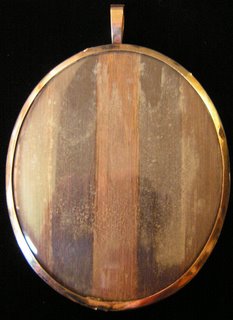Silhouettes
 “Shades are the truest representation that can be given of man” – Johann Lavater, 1804
“Shades are the truest representation that can be given of man” – Johann Lavater, 1804Shades, the old name given to silhouettes, became popular after about 1760 and were an outgrowth of the neoclassical revival. Silhouette artists were extremely influenced by both Johann Lavater and classical Greek art. Lavater, the father of the pseudo-science of physiognomy, believed that one’s internal qualities, emotions, intellect, capacity for achievement, and so forth, could be read from a profile of the face especially as a shade. Essentially physiognomy was the “science” of judging a book by its cover, but it was very popular with the producers and consumers of silhouettes. Ancient Greek black figure vases and red figure vases provided additional sources of inspiration and study for artists. For example, both Charles Rosenberg and Jacob Spornberg produced silhouettes in imitation of these silhouette-like vases. Silhouettes were produced on a variety of media including paper, plaster, and ivory.
Silhouette from Lavater’s treatise on physiognomy illustrating, “A man of business, with more than common abilities. Undoubtedly possessed of talents, punctual honesty, love of order, and deliberation. An acute inspector of men; a calm, dry, determined judge.”

Pair of unframed French mourning silhouettes, circa 1780, preumably representing a husband and wife. Both silhouettes are cut from black paper affixed to ivory and embellished with watercolor. Her silhouette bearing the inscription, "Il ne me reste que l'ombre," or "Only my shade remains," is surrounded by six tiny forget-me-nots.


John Miers (fl. 1760-1810) Silhouette of John Shore Lord Teigenmouth (1751-1834). He served as the Governor General of India from 1793-1797 and was made the First Baron Teigenmouth in the Irish Peerage in 1798. This Miers watercolor on plaster silhouette, c. 1800, is the earliest known portrait of John Shore. Price: $1400


Thomas R. Poole, wax medallion of Lord Teigenmouth, 1818, from the National Portrait Gallery.

George Richmond, watercolor of Lord Teigenmouth, 1832, from the National Portrait Gallery.
John Miers (fl. 1760-1810) Silhouette pair painted on ivory and signed "Miers" under the truncation. Price: $1800


John Miers (fl. 1760-1810) Silhouette painted on plaster and signed “Miers” under the truncation with braided hair surround and hairwork reverse. Unfortunately, cracked vertically. John Miers was the master of delineating the finely detailed diaphanous features of clothing.


J. H. Gillespie (fl. 1810-1838) Profile of English Lady c. 1815-20 bearing only the corner remnants of trade label #2. This profile is the type advertised as, "Likenesses, with the features neatly shaded on black grounds, in imitation of copper-plate busts, at 5s. each." He also offered bronzed silhouettes at 5s. and profiles "shaded in watercolor," that is full color profiles with his trademark blue brown crescent shading along the bottom edges of the miniature, for 7s. 6d. each. Gillespie advertised his work as "likenesses drawn in one minute" with the aid of "several mechanical and optical instruments" including a physiognograph, his version of the popular physiognotrace. Gillespie worked in America in the 1830s and at that time he charged 25 cents for silhouettes, 50 cents for the type of profile pictured below, $1 for bronzed silhouettes, and $2 for "features neatly painted in colors."




0 Comments:
Post a Comment
<< Home